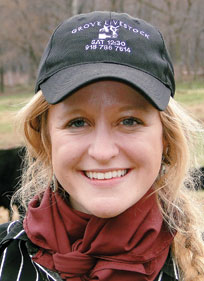 Kalyn McKibbin of Wyandotte, Okla., was only 11 years old when she had what she calls a “horse wreck.”
Kalyn McKibbin of Wyandotte, Okla., was only 11 years old when she had what she calls a “horse wreck.”
On that day, she was continuing to train a Quarter horse mare named Angel for ranch work. The horse had proven reliable, and she and the horse were comfortable with each other.
“The accident was all human error,” Kalyn said.
On that faithful day, Kalyn had decided to ride with a bosal, a halter-type ranch bridle without a bit. The two went to check the cows during the March calving season.
Kalyn got off her horse to shut a gate instead of doing it on horseback, as she usually did, and as she was getting back on, her horse spooked. Her foot became caught in the stirrup and she was dragged 100 yards until her face hit an oak stump that was protruding from the ground about a foot. The force of that collision shook her foot free, but the medical consequences were catastrophic.
Her entire body was covered with bruises and abrasions, her brow bone was shattered, her cheek broken and her jaw fractured. After arriving at the hospital in Joplin, Mo., she was immediately transported by helicopter to Mercy Hospital in Springfield, Mo., where her parents were informed that she wouldn’t be able to walk or speak again because the injury was so close to the brain that bone fragments were likely embedded inside.
That initial surgery was hours long, but showed no damage to Kalyn’s brain.
“I was in the hospital but I can’t even remember how long, partially because I was put into a medically-induced coma so my brain would not swell,” Kalyn recalled.
When she came home, she still had her right eye; but after six weeks of frequent checkups, the doctor informed the devastated family that the eye was deteriorating rather than healing. It had to be removed immediately or it would start stealing nutrients from the other eye and render Kalyn totally blind.
A second surgery removed her damaged eye and it was replaced with a custom implant attached to muscle, a coral ball with a hand-painted, contact lens-like surface to match the lost eye. Soon after, she had one minor cosmetic surgery to fix her eyelid.
Another result of the accident was Kalyn going into anorexic shock and losing all appetite. She lost weight until she weighed a mere 55 pounds with a 5-foot, 5-inch frame. Only now, eight years later, is her appetite getting back to normal.
Fortunately, Kalyn lost no education because she was homeschooled and the accident happened in late March, close to the end of the school year.
The spunky cowgirl was also back on the same horse two weeks after she got out of the hospital.
Kalyn’s parents had insurance but medical bills totaled $750,000. Between church fundraisers, chili feeds, rodeos and love offerings, as well as rigorous negotiations with the insurance company, all the bills were paid.
“Without the generous help of the community and the ultimate cooperation with the insurance company, we would’ve lost the ranch,” Kalyn said.
Kalyn has turned this tragedy into a personal, passionate drive. While standing next to the horse that threw her, Kalyn said, “When you get that close to death, you refocus, notice little things, and have goals. Now I see God’s hand all over my life and I want to fulfill his purpose for me.”
As a junior at Oklahoma State in Stilwater, Okla., majoring in animal science business and ag economics, Kalyn is creating and grabbing opportunities at every turn. She is one of only five on the Beef Ambassador Team for the entire country. She was selected after a rigorous competition, including issue responses to a negative article, media interview questions about beef production and modern practices, and creating an educational outreach project speaking to a campus sorority about the nutritional value of beef. Her duties include extensive travel targeting Millennials and their understanding of beef production, nutrition and preparation. Activities include cooking shows, expos and using promotional pamphlets.
Kalyn is also the Oklahoma Collegiate Cattlewoman’s president and the collegiate representative on the American National Cattlewoman’s Association Board of Directors. Future plans include pursuing a master’s degree with a career goal of bridging the gap between producers and consumers.
This summer she is interning with the Sam Roberts Noble Foundation Research Agricultural Division and will be working on sustainable and practical agricultural management practices. She also wants to be a commercial beef producer and has a clear expectation of her herd’s composition. She wants black-hided heterogeneous cows with Sim-flex bulls and Herefords as clean ups. For now, she goes home as often as she can to work on her family’s ranch.
“The only advice I can give is to never, ever be, comfortable and let your guard down no matter how routine or familiar the task,” Kalyn said. “This is especially true with animals, and you have to plan on the unexpected happening not some time, but right now.”







